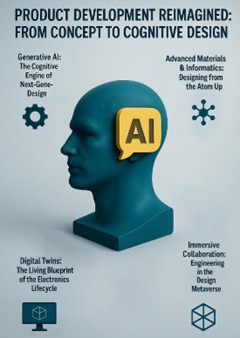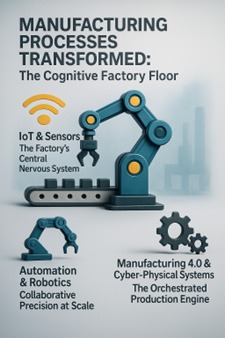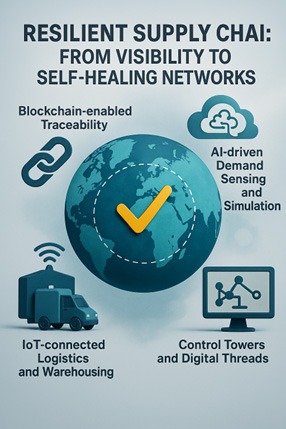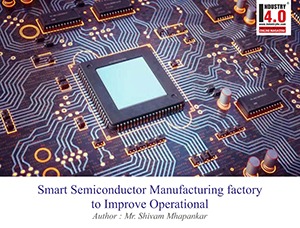Executive Summary: Engineering the Future, Intelligently and Sustainably
The electronics industry is being fundamentally reshaped, taking it beyond mere digital optimizations into converged, cognitive, and always learning ecosystems. This revolution changes the way we innovate, make, and connect, ultimately empowering individuals and driving progress.
• Immersive & Intelligent Electronics redefine design, manufacturing, and supply chains through integrated data and AI decision-making, delivering real benefits.
• IoT, robotics, AR/VR, Digital Twins, and generative AI propel market efficiency and expansion, as attested by 25% improved time-to-market.
• End-to-end orchestration of products implies complete control, from chip design to customer touchpoint, linked by an uninterrupted digital thread.
• Real-world examples demonstrate measurable outcomes, like 15% yield improvement in semiconductor manufacturing through AI optimization.
• Eventually, a distinct digital transformation roadmap comes into view, centered on resilience, human potential, and sustainable competitive advantage.
Introduction: Engineering the Future of Electronics—Beyond Smart, Toward Self-Optimizing and Human-Empowered
The electronics sector is undergoing deep structural change to become an integrated, cognitive, and adaptive network that actually learns. Working extensively with world electronics leaders, I’ve witnessed firsthand how engineering, manufacturing, and supply chain operations are being rewired as smart, real-time feedback loops.
We are moving towards the Immersive & Intelligent Electronics era. In this space, transformational technologies such as Generative AI, Digital Twins, Augmented/Virtual Reality (AR/VR), AI/Machine Learning (AI-ML), Internet of Things (IoT)/Edge computing, and high-end Automation/Robotics are mission-critical drivers for the entire product life cycle. This is not theory; we are seeing it get delivered at production scale, transforming every phase:
• Smart Product Development: GenAI-led design, high-fidelity multi-physics simulation, and rapid iteration accelerate innovation. A leading fabless semiconductor company reduced verification cycles by 30% with GenAI.
• Factory Upgrade: Hyper-sensorization offers unparalleled visibility, autonomous quality inspection guarantees perfection, and AR-based manufacturing empowers staff with superhuman accuracy. An EMS provider saw 20% rework reduction through AI-powered visual inspection.
• Closed-loop Supply Chains: We employ blockchain for trust and visibility along with real-time performance feedback from fielded products. One of the leading medical device manufacturers improved component traceability by 40% using a blockchain-based supply network.
This article outlines the way to design and deploy advanced systems globally. It shares insights from real-world projects, complex business software integrations, and robust design-to-delivery processes. For business executives and engineering strategists, the message is evident: we are infusing intelligence into the entire end-to-end value chain—chips to ultimate customer experience. This is not just about making smart products, but an intelligent, responsive, and resilient future.
Product Development Reimagined: From Concept to Cognitive Design
Product development in semiconductors, Power & Automation Equipment, Network Equipment Providers (NEPs), Office Products & Computers (Digital office), Medical Devices/Equipment, Consumer Electronics and Home Appliance is being reimagined. The classical, linear design process is giving way to a smarter, agile, hyper-collaborative method. With AI-driven design automation, virtual reality engineering environments, and material informatics coming together, design is becoming more cognitively oriented.

Generative AI: The Cognitive Engine of Next-Generation Design
Generative AI (GenAI) revolutionizes design from reactive engineering to forward-looking, cognitive innovation—the “brain” of the digital factory for design. GenAI iterates over millions of design options, optimizing power dissipation, thermal characteristics, manufacturability, signal integrity, and cost, all while adhering to precise product requirements. McKinsey predicts that AI can release trillions of dollars of value across sectors, radically changing product development.
In fabless semiconductor companies, GenAI rapidly cycles through System-on-Chip (SoC) floor planning to achieve demanding Power-Performance-Area (PPA) goals. It’s able to search billions of gate-level place-and-route configurations for optimization, supporting intelligent hardware co-design of AI/ML models. In medical devices, it’s critical to designing ultra-miniature, high-reliability PCBs with optimized component density and thermal profiles. NEPs leverage it to optimize electromagnetic performance in complex antenna arrays, simulating complicated signal propagation. In consumer electronics, GenAI redefines product enclosures, engineering the best ergonomics and thermal balancing.
Future-proof solutions such as Synopsys.ai, Cadence Cerebrus, and Ansys Discovery embed intelligence directly within Electronic Design Automation (EDA), simulation, and optimization flows. This accelerates design cycles from months to days through automating iterative tasks. Industry trends validate that GenAI reduces EDA cycle times dramatically and increases yield predictability. Anomaly detection engines based on AI also accelerate GenAI, anticipating problems such as heat dissipation or EMI compliance weeks ahead of physical prototyping—a key pain point in eliding expensive re-spins. The outcome is a fundamental shift: from “what if” to “what’s optimal” at breathtaking speed.
Advanced Materials & Informatics: Designing from the Atom Up
Materials for high-performance electronics are no longer passive substrates; they actively propel functional innovation. From Gallium Nitride (GaN) and Silicon Carbide (SiC) for EV charging and smart grids, to flexible, biocompatible polymers for medical sensors, selection of the material determines the cutting edge of product innovation.
Material Informatics—a data-driven strategy—facilitates materials discovery and optimizes properties at an unprecedented speed. This is accomplished by applying computational simulations and machine learning methods to massive databases of materials to make predictions about behavior and create new compositions. The engineers can optimize manufacturability, sustainability, and performance simultaneously. Using computational simulations, the engineers create very light, impact-resistant composites for drones, high-dissipation alloys for data centers, and flexible substrates for foldable consumer electronics. New technologies such as neuromorphic sensing technologies set boundaries for edge AI and energy efficiency. The design of products now begins with smart material selection, allowing innovation in industries.
Digital Twins: The Living Blueprint of the Electronics Lifecycle
Digital Twins have moved from being static CAD models to real-time, updating virtual duplicates of the entire product lifecycle. The next-generation Product Lifecycle Management (PLM) solutions such as Siemens Teamcenter, PTC Windchill, and Dassault Systèmes 3DEXPERIENCE drive this change. These “living models” use real-time information, physics-based simulation, and runtime telemetry. IDC predicts the worldwide Digital Twin market to grow over $75 billion by 2027.
• End-to-End Design Verification: Digital twins facilitate rigorous design verification with the help of virtual prototyping. Fabless semiconductor companies virtually model Signal Integrity (SI) and Power Integrity (PI) characteristics to enhance tape-out yields, minimizing expensive re-spins by up to 10%. Consumer electronics designers virtually model enclosure stress, drop-test results, and thermal dissipation. Medical device engineers model device performance with great care for regulatory approval.
• Optimization Digital Production: OEMs and EMS providers leverage digital twins to simulate assembly lines virtually. This identifies bottlenecks, optimizes robotic trajectories, and eliminates defects prior to physical build, maximizing throughput. A pre-qualified robotic PCB insertion was pre-qualified by a smart appliance OEM, saving 18% on the cost of physical prototyping.
• Field-Embedded Closed-Loop Feedback: IoT telemetry embedded within field-deployed products enables them to keep sending operation data to their digital twin perpetually, establishing an ongoing feedback loop. This enables predictive maintenance on high-risk hospital monitors, real-time balancing of loads in smart grids, and adaptive firmware tuning in home appliances. In consumer electronics, products become smart, learning user patterns and delivering customized experiences and predictive maintenance. Products actually change, getting smarter with each passing moment.
Immersive Collaboration: Design Engineering within the Design Metaverse
Virtual and Augmented Reality (VR/AR) technologies transform multidisciplinary team collaboration into the creation of a “design metaverse.” Environments such as NVIDIA Omniverse, Unity Reflect, and Autodesk VRED enable globally distributed teams to collaborate naturally on virtual prototypes at full size in real-time 3D spaces, supporting concurrent engineering. The global VR market is growing at an explosive pace, projected more than $22 billion by 2025 (IEEE Spectrum).
• Cross-Functional, Global Design Reviews: Immersive collaboration facilitates critical global design reviews through shared, interactive virtual spaces. Semiconductor engineers review complex 3D chip layouts for manufacturability and signal integrity remotely. NEPs and Office Products & Computers companies co-design enclosures for best component placement and airflow. Medical device engineers utilize virtual models (e.g., Osso VR) for joint reviews of device interfaces for usability and patient safety—a critical capability for regulatory such as ISO 13485. EMS providers heavily utilize VR for dynamic review of design, with 20% fewer review cycles.
• AR–Powered Training and Troubleshooting: Solutions such as Microsoft HoloLens 2 and Magic Leap 2 project real-time schematics, diagnostics, or instructions directly onto real hardware with AR overlays. This offers context-aware, hands-free directions for intricate processes. This allows accurate debugging of NEP routers, supports in-field training of EMS staff, and simplifies ECU enclosure design. Chipmakers also employ AR increasingly for maintenance and repair. These interactive technologies eliminate silos, shorten review cycles, and bring stakeholders together in a shared, dynamic space.
Manufacturing Processes Transformed: The Cognitive Factory Floor
Having managed extensive digital transformations of electronics plants firsthand, I can say categorically: the factory is no longer a one-dimensional assembly line. It is vibrant, smart, and constantly evolving in real-time through the entire range of electronics manufacturing. This is the concrete reality of Industry 4.0 and its follow-on waves—a master plan that I’ve implemented actively for unprecedented strength and resilience.

IoT & Sensors: The Factory’s Central Nervous System
Ubiquitous IoT sensors are the “Muscles of Precision & Flow” of modern electronics manufacturing. They collect granular data around the clock, providing the real-time rhythm of the business, enabling proactive rather than reactive management. IDC forecasts industrial IoT (IIoT) manufacturing outlay will expand steadily, fueling efficiency and predictive maintenance. Vibration sensors on key equipment in semiconductor fabs anticipate maintenance, protecting precious wafer yields. For Power & Automation Equipment, IoT data forecasts electromechanical failure, enabling proactive maintenance. NEPs monitor motion of components to avoid bottlenecks. Even in Medical Device cleanrooms, advanced environmental sensors measure air quality, temperature, and humidity to satisfy strict regulatory requirements.
Industrial IoT platforms such as Siemens MindSphere, PTC ThingWorx, and GE Digital Predix provide the substrate for processing this fine-grained real-time data. Most importantly, Edge-AI offerings (e.g., AWS IoT Greengrass or Azure IoT Edge) run computing on the shop floor. Local processing reduces latency to make ultra-low latency decision-making possible for precision robotics, autonomous quality inspection, and adaptive machining. For example, an Asian EMS plant reduced unplanned downtime by 15% through using Edge AI for predictive maintenance on SMT machines.
Automation & Robotics: Precision Collaboration at Scale
Modern robots have evolved from stand-alone automatons; today they are true human collaborative tools, absolutely necessary to scale complexity and accuracy in manufacturing. Advanced robots perform precise operations, ranging from micro-soldering sensitive semiconductor parts to high-volume pick-and-place of consumer electronics. At the same time, specialized cobots enhance human operator accuracy, collaborating together. Such human-robot collaboration, facilitated by AR for intuitive guidance, is Industry 5.0’s people-first principle—a strategic imperative to maximize effectiveness and worker engagement.
In medical device assembly, robotic precision for high-precision work is supplemented by human dexterity for fine manual tasks. For power & automation equipment, rugged automation pushes large, heavy parts around with precision, improving safety and speed of assembly. High-speed adaptive automation allows Network Equipment Providers to quickly handle multiple product variations and speed New Product Introduction (NPI) cycles. This potent combination of robotic automation and human ingenuity significantly boosts throughput and quality. For example, a leading European electronics OEM achieved a 12% increase in line efficiency by integrating cobots for complex assembly tasks.
Manufacturing 4.0 & Cyber-Physical Systems (CPS): The Orchestrated Production Engine
As an SAP S/4HANA and Smart Manufacturing Strategist, Manufacturing 4.0 principles are the very core of intelligent factories. They allow for Cyber-Physical Systems (CPS), in which process and machine worlds meet and collaborate. Leading Manufacturing Execution Systems (MES) such as SAP Digital Manufacturing, Siemens Opcenter APS, and Rockwell Automation FactoryTalk ProductionCentre are the shop floor’s orchestrating layer, crunching the critical orchestration between enterprise planning (ERP) and real-time execution.
These MESs, which are natively tied to real-time IoT information and high-performance ERP solutions (like SAP S/4HANA), enable intelligence for autonomous decision-making. In semiconductor manufacturing, this equates to dynamically adjusting process parameters against real wafer quality feedback, maximizing yield. For Power & Automation Equipment, MES manages complex assembly sequences with stringent quality gates and complete material traceability. In Network Equipment Provider manufacturing, these systems fine-tune machine settings or re-route products for high-mix, high-volume manufacturing.
For Office Products & Computers, MES supports perfect component traceability and optimized assembly for mass customization. In Medical Device manufacturing, it applies rigid batch control, delivers secure audit trails to satisfy GxP standards (e.g., ISO 13485 and FDA 21 CFR Part 820), and supplies automated notification of parameter drifts—essential to patient safety. In Consumer Electronics, these systems deliver prognostic maintenance of vital equipment, minimizing downtime. Si-View (a purpose-built MES for test and electronics assembly) interfaces perfectly with ERP and PLM, delivering unparalleled design-to-production traceability and automated fix processes. Such end-to-end orchestration makes the cognitive factory unconquerable.
Resilient Supply Chain: From Visibility to Self-Healing Networks
I’ve seen many supply chain disruptions. Old methods don’t work anymore. We need adaptive, digitally-connected, self-optimizing networks using Supply Chain 5.0 designs to handle today’s challenges.
Blockchain is essential for trustworthy tracking in supply chains. My insights underscore the critical necessity for immutable traceability. For electronic components and semiconductors, blockchain verifies origin, prevents counterfeiting, and ensures ethical sourcing by offering an immutable ledger. For healthcare electronics, blockchain provides an unalterable piece-by-piece audit trail that is essential for regulatory compliance and patient safety. Circularise type of technologies also allows safe and decentralized information exchange for circular economy use cases. Gartner forecasts that by 2025, 30% of supply chain manufacturers with more than $1 billion in revenue will leverage blockchain for supply chain traceability. We have already observed EMS providers lowering warranty claims due to counterfeit components by 8% by employing blockchain-based provenance tracking.

AI-based Demand Sensing and Simulation: From Reactive to Predictive Resilience
As a Digital Transformation Leader, utilizing AI has been key to enabling companies to shift from reactive operations to anticipatory actions, avoiding supply chain volatility. For consumer electronics, this translates to correctly anticipating unexpected surges in demand in order to maximize inventory, resulting in up to a 10% drop in excess stock. For network equipment, AI-driven simulations predict component shortages, facilitating dynamic re-planning and secondary sourcing, and playing a large role in network resilience. This is done via sophisticated demand data models and predictive analytics inputting into planning systems.
IoT-empowered Warehousing and Logistics: Dynamic Control and Real-time Visibility
Our implementations use IoT in ways far beyond low-level location tracking, transforming logistics by delivering nuanced, real-time visibility into inventory and movement. For valuable items such as semiconductor parts or medical equipment, real-time condition monitoring avoids expensive in-transit damage. In power & automation machinery equipment, IoT streamlines heavy shipment routing and tracking of high-value assets. For office and computer equipment, dynamic assignment of inventories optimizes warehousing efficiency and ensures accurate, on-time delivery. An Asian semiconductor logistics company enhanced delivery accuracy by 15% by implementing IoT sensors on shipments.
Control Towers and Digital Threads: Choreographing the Self-Healing Network
Modern supply chains use advanced systems called Supply Chain Control Towers, often with platforms like SAP IBP or Kinaxis Rapid Response. These systems offer a complete, global view, helping manage everything from complex, long-term projects (like automation equipment) to hundreds of computer parts. They connect all the moving pieces, providing a single view of complex relationships.
A continuous digital thread ties everything together, allowing for quick adjustments and real-time risk management across complicated supplier networks. All your different business systems, like those for planning, warehousing, and transport, are connected through APIs, creating a unified data picture.
The outcome is truly a closed-loop supply chain that learns, adapts, and self-heals. This is not an evolutionary step; it is a systemic, sustainable competitive advantage for electronics OEMs, ODMs, and EMS suppliers in an inherently unpredictable world.
Ethics and Compliance Dilemmas in the Intelligent Ecosystem
While the intelligent ecosystem is unrivaled for efficiency and innovation, it also requires vigilant ethical examination and strict compliance. Systemic IoT deployment has data privacy concerns, requiring rigorous cybersecurity and GDPR or CCPA compliance. Higher automation requires futuristic retraining and upskilling initiatives for fair labor transition. Compliance is not optional; it’s mandatory. Conformance to industry standards (ISO, IEC) and regulatory requirements (FDA for medical devices, ISO 26262 for automotive safety) is vital for product reliability, safety, and marketability. Folding these issues into each deployment stage guarantees sustainable, responsible innovation. This is tackled through the deployment of strong data governance structures and secure API management for system interoperability.
USE CASE DEEP DIVE: PCBA Manufacturing Optimization for a Global EMS Company
A worldwide Electronics Manufacturing Services (EMS) company struggled with fluctuating OEE (Overall Equipment Effectiveness) and excessive rework in its PCBA plants. In response, they embarked on an enterprise-level digital transformation initiative incorporating a number of core technologies:
• Predictive Quality Edge AI: Vibration sensors and high-resolution cameras were mounted on SMT lines. Edge AI models processed real-time video streams for component placement accuracy and solder paste inspection, and vibration patterns for predictive maintenance. This resulted in 22% OEE improvement with drastic reduction of unplanned downtime and proactive defects detection.
• AR-Guided Inspection and Rework: AR headsets (e.g., Microsoft HoloLens) were worn by operators to superimpose digital work instructions, schematics, and highlight defects on physical PCBs. This lowered human inspection error rates by 18% and sped up rework by delivering accurate, contextual instructions.
• Digital Twin-Based Layout Optimization: A Digital Twin of the entire factory floor combined data from MES, PLM, and ERP systems. This twin was simulated in order to optimize production flows and layout, detecting bottlenecks and material handling routes prior to actual implementation. This virtual commissioning reduced line re-configuration times by 15%.
This advanced technology helped the EMS company significantly improve efficiency, quality, and responsiveness, setting a new benchmark for smart manufacturing.
Conclusion: The Human Imperative in an Intelligent Future
The electronics industry’s transformation is profoundly human. Progress lies in intelligent ecosystems where AI, Digital Twins, and advanced automation empower people and foster substantial progress. This resilient future, built on NextGen ERP, Manufacturing 5.0, Agentic AI, and a connected Digital Thread, holds immense promise. Leaders in electronics must adopt these solutions today to unlock sustainable competitive edge and create a more adaptive, human-centric world.
About the Author :

Mr. Shivam Mhapankar PMP®ITIL®
NextGeN ERP Account & Business Development Executive -Hi-Tech Industry
IBM Consulting
Mr. Shivam Mhapankar is a Digital Transformation and SAP S/4HANA Program Leader with over 25 years of experience driving innovation across the Hi-Tech Electronics industry.
He collaborates with global discrete industry organizations to integrate AI, IoT, Digital Twins, and NextGen ERP into intelligent, resilient operations.
Renowned for seamlessly blending strategy with execution, Shivam leads complex, multi-region programs that consistently deliver measurable business outcomes at scale.
Shivam is the Sr. SAP S/4 HANA Program Manager & Business Development Executive for the Hi-Tech Industry, for IBM Consulting-CIC India. He has a 20+ years track record driving innovation and changes in the Electronics Industry in supply chain operations, information technology, and enterprise business transformation to enable profitable revenue growth. He has broad-based strategic, business, consulting, and project management skills gained over years of experience in the industry.
Mr. Shivam Mhapankar PMP®ITIL® is Bestowed with the following Licenses & Certifications :
https://www.linkedin.com/in/sh
Mr. Shivam Mhapankar can be contacted at
E-mail | E-mail | LinkedIn | + 91-99308 61764
Also read Mr. Shivam Mhapankar earlier article :














